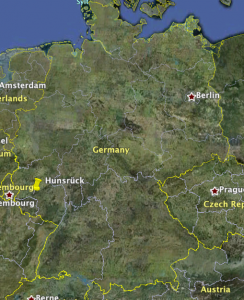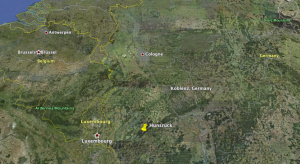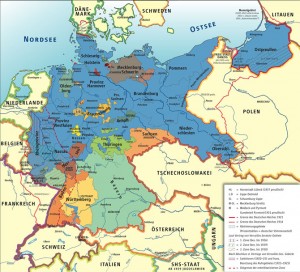We’ll discuss both the real-world and the fictional backdrop of Heimat during our first class session, but I thought you would appreciate a little bit of information to help get you started.
The majority of the show takes place in the fictional village of Schabbach, Germany, a composite of several actual villages in the Hunsrück, a remote mountainous region near the border with France that is also the real-world home of filmmaker Edgar Reitz. “Hunsrück” is the German name for the eastern outskirts of the Ardennes mountain range, which would become famous during the Second World War as the site of Germany’s last stand against the advancing U.S. Army. The exact location of Schabbach is never revealed, but the closest real-world town is Simmern (this is where Pauline will move after marrying the jeweler Robert), the closest slightly larger town is Koblenz (where Paul go to buy the parts for his radio).
Here is a Google Earth screenshot showing the rough location of the Hunsrück in relationship to the rest of Germany:
 And here’s another screenshot, showing a closer view of the region with the borders and some of the larger cities marked:
And here’s another screenshot, showing a closer view of the region with the borders and some of the larger cities marked:
 The first episode of Heimat takes place from 1918 to 1928 and thus covers the immediate aftermath of the First World War and the majority of the duration of the Weimar Republic. The Weimar Republic was the first democracy on German soil and lasted until Hitler seized power in 1933. You don’t need to know very much about German history to follow what is going on; besides the First World War, the only major event to which this episode devotes considerable attention is the hyperinflationary period from 1922 to 1923, when the German currency lost almost all of its value.
The first episode of Heimat takes place from 1918 to 1928 and thus covers the immediate aftermath of the First World War and the majority of the duration of the Weimar Republic. The Weimar Republic was the first democracy on German soil and lasted until Hitler seized power in 1933. You don’t need to know very much about German history to follow what is going on; besides the First World War, the only major event to which this episode devotes considerable attention is the hyperinflationary period from 1922 to 1923, when the German currency lost almost all of its value.
One other detail that may not be immediately obvious even to those of you who have studied European history is that the Hunsrück, like all the German regions bordering France, was under French military occupation for most of the 1920s. This is alluded to most openly in the scene in which we see Eduard and his friends throw rocks at a French garrison.
Here’s a political map of Germany in the 1920s. The dotted red line running partly through modern-day France shows the German border in 1914, before the outbreak of the First World War, the solid red line shows the German border in 1920, after the Versailles treaty. The shaded areas inside the western rim of this later border are the occupied zones.
You’ll no doubt have other questions as well, but this should be more than enough information to get you started. Remember that this is not a history lesson; as always, focus on how the film works and on what kind of world it creates for us.

